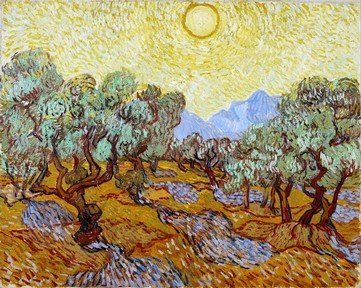Quiz Answer Key and Fun Facts
1. One surprisingly small painting, showing one woman, in one innovative pose, with one mysterious and intriguing smile: our first work could only be the "Mona Lisa." Who painted this masterpiece?
2. One of Michelangelo's most famous paintings tells the Biblical story of the creation of Man -- and it all comes down to two fingers. Adam, sculpted from clay, reclines on the ground; God, borne aloft by angels, extends a finger toward His creation; and their fingertips nearly meet in a moment that almost crackles with excitement. Where can this painting be found?
3. Like many Renaissance artists, when Raphael wished to paint compositions of three people, he returned often to a certain theme: the Virgin Mary in full maternal splendor. In his "Madonna of the Chair," painted in 1514, a serene Mary bows her head over the infant Jesus, held close on her lap; a second child, a toddler, gazes lovingly at her. Who was this second child, a regular in three-person "Madonna" paintings of the era?
4. Hanging on a wall of the Louvre are four 1573 paintings by Giuseppe Arcimboldo: "Spring," "Summer," "Autumn" and "Winter." Each canvas depicts the head of a man in profile -- but there is something very unusual about these portraits. What is it?
5. There are five people in the 1669 painting "The Return of the Prodigal Son": a repentant young man kneels before his father, as three other men look on. This was not the artist's first depiction of this Bible story: 34 years earlier, he had produced a famous portrait of himself as the Prodigal Son in happier times, which was an excellent excuse to paint his wife Saskia on his lap. Who was the Dutch Grand Master who painted these works?
6. In 1888 and 1889, a Dutch artist painted three versions of his bedroom in Arles, France. In each version, there are six paintings hanging on the room's blue walls; some of them recall other works by the same artist. Who painted this gentle tableau of a room with decidedly odd corners?
7. There's an old joke that runs like this: 6 is afraid of 7 because, well, 7 ate 9. Seven has always been a rather surreal number, so of course it turns up in one of Salvador Dalí's most famous works. Several distorted, melting clocks adorn a beach; the largest of these, a gold watch folded over a wooden block, shows a time of nearly seven o'clock. What is the title of the painting?
8. There are eight pathetic figures in Pablo Picasso's 1937 canvas "Guernica": a horse, a bull, a dead soldier and a dead infant, and four living people, grieving and desperate. Picasso painted this piece as a response to what tragic event?
9. For the number nine, we turn to Panel 59 of an epic sixty-painting series depicting the northward "Great Migration" of African-Americans after World War I. In this panel, a white guard watches nine black voters on Election Day; the caption says, "In the North, they had the freedom to vote." Which artist painted this scene in the early 1940s?
10. Andy Warhol and his Pop Art bring us to ten. In the early 1960s, he began a series of works, all depicting a certain everyday object. His 1969 addition to the series showed ten of the objects, neatly arranged in two rows of five. What are the ordinary items that Warhol made fascinating?
Source: Author
CellarDoor
This quiz was reviewed by FunTrivia editor
LadyCaitriona before going online.
Any errors found in FunTrivia content are routinely corrected through our feedback system.

